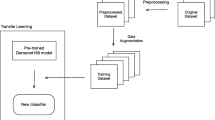Abstract
Body constitution is a classification of individuals into different types of physical condition in order to prevent disease and promote health. The problem of standardizing constitutional classification has become a constraint on the development of Chinese medical constitution. Traditional recognition methods, such as questionnaire and medical examination have the shortcoming of inefficiency and low accuracy. We present an advanced deep convolutional neural network (CNN) to simulate the function of pulse diagnosis, which is able to classify an individuals constitution based only his or her pulse. The CNN model employed the latest activation unit, rectified linear unit and stochastic optimization. This model takes the lead in trying to classify individual constitution using CNN. During the experiment, the CNN model attained a recognition accuracy 95 % on classifying 9 constitutional types.
Access this chapter
Tax calculation will be finalised at checkout
Purchases are for personal use only
Similar content being viewed by others
References
Wang, Q.: Classification and diagnosis basis of nine basic constitutions in Chinese medicine. J. Beijing Univ. Tradit. Chin. Med. 28(4), 1 (2005)
He, H., Bai, Y., Garcia, E.A., Li, S.: Adasyn: adaptive synthetic sampling approach for imbalanced learning. In: IJCNN, pp. 1322–1328. IEEE (2008)
Xu, B., Wang, N., Chen, T., Li, M.: Empirical evaluation of rectified activations in convolutional network. CoRR, abs/1505.00853 (2015)
He, K., Zhang, X., Ren, S., Sun, J.: Delving deep into rectifiers: surpassing human-level performance on imagenet classification. CoRR, abs/1502.01852 (2015)
Kingma, D.P., Ba, J.: Adam: a method for stochastic optimization. CoRR, abs/1412.6980 (2014)
Srivastava, N., Hinton, G., Krizhevsky, A., Sutskever, I., Salakhutdinov, R.: Dropout: a simple way to prevent neural networks from overfitting. J. Mach. Learn. Res. 15, 1929–1958 (2014)
Hoerl, A.E., Kennard, R.W.: Ridge regression: biased estimation for nonorthogonal problems. Technometrics 12, 55–67 (1970)
Chollet, F.: Keras (2015). https://github.com/fchollet/keras
Acknowledgments
This study was supported by the key project of MOST basic work 2013 (No. 2013FY114400), National Natural Science Foundation of China (No. 81403325), Ministry of Education-China Mobile Research Fund under grant MCM20130381 and Tsinghua University Initiative Scientific Research Program (No. 20131089190). Beijing Key Lab of Networked Multimedia also supports our research work.
Author information
Authors and Affiliations
Corresponding authors
Editor information
Editors and Affiliations
Rights and permissions
Copyright information
© 2016 Springer International Publishing Switzerland
About this paper
Cite this paper
Li, H., Xu, B., Wang, N., Liu, J. (2016). Deep Convolutional Neural Networks for Classifying Body Constitution. In: Villa, A., Masulli, P., Pons Rivero, A. (eds) Artificial Neural Networks and Machine Learning – ICANN 2016. ICANN 2016. Lecture Notes in Computer Science(), vol 9887. Springer, Cham. https://doi.org/10.1007/978-3-319-44781-0_16
Download citation
DOI: https://doi.org/10.1007/978-3-319-44781-0_16
Published:
Publisher Name: Springer, Cham
Print ISBN: 978-3-319-44780-3
Online ISBN: 978-3-319-44781-0
eBook Packages: Computer ScienceComputer Science (R0)




